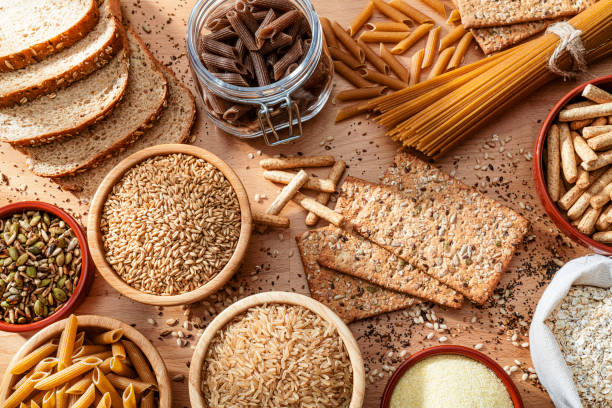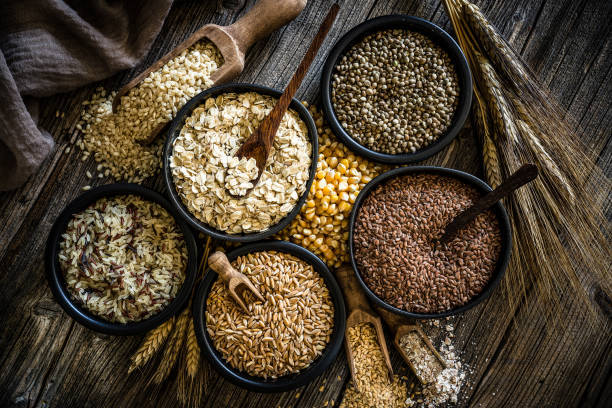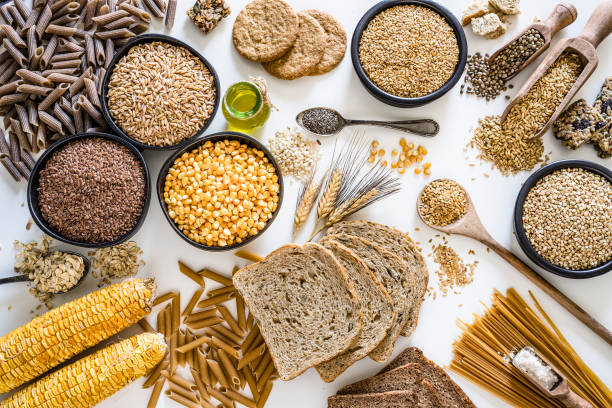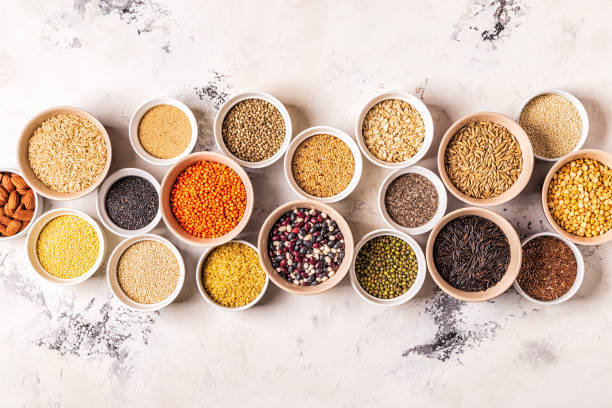Managing diabetes isn’t always easy, but what you eat plays a big role. One simple way to take control? Add more whole grains to your meals. Whole grains help with diabetes by keeping blood sugar levels steady, supporting better digestion, and lowering the risk of heart problems.
Let’s dive into why whole grains are a smart and powerful choice for a diabetes-friendly diet.
What Are Whole Grains?
Whole grains are grains that include all three parts of the grain kernel. Each part plays a role in giving your body key nutrients:
- Bran: The outer layer, full of fiber and antioxidants
- Germ: The core, packed with vitamins, minerals, and healthy fats
- Endosperm: The middle layer, providing carbohydrates and protein
Unlike refined grains, whole grains keep all these parts. That means they offer more nutrients and health benefits in every bite. parts. That means they’re more nutritious and better for blood sugar control.

Why Whole Grains Help with Diabetes
1. Slower Digestion = Stable Blood Sugar
Whole grains are full of fiber, which slows down digestion. When your body digests food more slowly, sugar enters your bloodstream at a steadier pace. This helps prevent big spikes in blood sugar after meals.
The American Diabetes Association says that eating more fiber can improve blood sugar control and lower insulin resistance (source).
2. Lower Glycemic Index
The glycemic index (GI) shows how quickly a food raises your blood sugar. Foods with a high GI cause fast spikes, while low-GI foods lead to slower, steadier rises. Whole grains usually have a lower GI than refined grains, which makes them a better choice for people managing diabetes.
Some great low-GI whole grains include:
- Steel-cut oats
- Quinoa
- Barley
- Bulgur
These grains can help keep your blood sugar steady and your energy levels balanced throughout the day.
3. Packed with Nutrients
Whole grains give you more than just fiber. They’re loaded with important nutrients that help your body manage blood sugar, including:
- Magnesium: Helps your body use insulin more effectively
- Chromium: May boost insulin sensitivity
- B vitamins: Support energy and a healthy metabolism
These nutrients team up to support better blood sugar control and overall health.
Best Whole Grains for Diabetes
Picking the right grains can make a big difference in managing blood sugar. Whole grains are a smart choice, but some are better than others for people with diabetes.
Here are some of the best whole grains to add to your diet:
1. Oats
Oats are one of the best foods for people with diabetes. They’re rich in beta-glucan, a type of fiber that helps slow digestion, lower blood sugar, and reduce cholesterol levels.
Tip: Choose steel-cut or rolled oats for the most benefits. Try to avoid instant oats, as they often contain added sugars and have a higher glycemic index.
2. Quinoa
Quinoa is a nutritious, gluten-free grain that’s high in both protein and fiber. It has a low glycemic index, which means it won’t cause rapid spikes in blood sugar. Plus, quinoa helps you feel full longer, making it a great choice for managing appetite and blood sugar levels.
3. Barley
Barley is a whole grain packed with soluble fiber, which helps lower blood sugar levels and supports heart health. The fiber in barley also helps control appetite and promotes better digestion, making it a great addition to any diabetes-friendly diet.
4. Brown Rice
Brown rice is a healthier choice compared to white rice. Unlike white rice, it retains the bran and germ, which means it digests more slowly and has a lower glycemic index. This helps prevent rapid blood sugar spikes and keeps your blood sugar levels more stable.
5. Bulgur
Bulgur is a fast-cooking whole grain that’s high in fiber. Its mild, nutty flavor makes it a versatile choice for a variety of dishes, including salads, soups, or as a healthy side dish. Because it digests slowly, bulgur helps maintain steady blood sugar levels.
How Whole Grains Help Prevent Type 2 Diabetes
Incorporating whole grains into your daily meals can help lower the risk of developing type 2 diabetes.
A major study from the Harvard T.H. Chan School of Public Health found that people who ate the most whole grains had a 29% lower risk of developing type 2 diabetes (source).
This shows that a small change, like adding more whole grains to your diet, can have a big impact on your health!

Whole Grains vs. Refined Grains: What’s the Difference?
Refined grains go through processing that removes the bran and germ, which also takes away most of their fiber and essential nutrients. Common refined grains include:
- White rice
- White bread
- Regular pasta
These grains digest quickly, leading to fast spikes in blood sugar. In contrast, whole grains retain all parts of the grain, so they digest more slowly. This helps keep your blood sugar levels stable and supports better overall health.
Here’s a quick comparison:
| Whole Grains | Refined Grains |
|---|---|
| Oats | Instant oatmeal |
| Brown rice | White rice |
| Whole wheat bread | White bread |
| Quinoa | Couscous |
| Barley | White flour products |
How to Add More Whole Grains to Your Diet
You don’t need to completely change your diet all at once. Start with simple swaps to gradually add more whole grains to your meals:
- Breakfast: Choose oatmeal or steel-cut oats instead of sugary cereals.
- Lunch: Try a quinoa salad or use a whole wheat wrap for your sandwich.
- Dinner: Swap white rice for brown rice, barley, or another whole grain like farro.
- Snacks: Reach for whole-grain crackers, or enjoy air-popped popcorn (skip the butter!).
When shopping, always check food labels for “100% whole grain” or “whole wheat” as the first ingredient. Avoid products that list “enriched” or “refined” on the label. wheat” as the first ingredient. Avoid products that say “enriched” or “refined.”
Whole Grain Recipes for Blood Sugar Control
Looking for delicious and easy ways to add whole grains to your meals? Try these simple, diabetes-friendly recipes that are both tasty and help manage blood sugar levels:
1. Overnight Oats
Combine rolled oats with almond milk, chia seeds, and fresh berries. Stir everything together and let it sit in the fridge overnight. In the morning, you’ll have a delicious, ready-to-eat breakfast that’s packed with fiber and nutrients to support healthy blood sugar levels.
2. Quinoa Bowl
Cook quinoa and top it with your favorite grilled vegetables, black beans, and creamy avocado. A squeeze of fresh lime adds a burst of flavor. This nutrient-packed bowl is perfect for lunch or dinner and provides a balanced combination of fiber, protein, and healthy fats to help maintain stable blood sugar levels.
3. Barley Soup
Simmer barley in low-sodium vegetable broth along with carrots, spinach, and any of your favorite herbs. This hearty, fiber-rich soup is not only filling but also a great way to add more whole grains to your diet. It’s perfect for a cozy lunch or dinner, helping to stabilize blood sugar while providing essential vitamins and minerals.
FAQs About Whole Grains and Diabetes
Are All Whole Grains Safe for People with Diabetes?
Most whole grains are safe and beneficial for people with diabetes. However, portion size is key. Even healthy carbohydrates can cause blood sugar levels to rise if eaten in large amounts. It’s important to manage portions and balance your meals for optimal blood sugar control.
How Much Whole Grain Should I Eat Daily?
For optimal health and blood sugar control, aim for at least 3 servings of whole grains each day. Here are some examples of what counts as one serving:
- ½ cup of cooked oatmeal
- 1 slice of whole wheat bread
- ½ cup of cooked brown rice
Incorporating these servings into your daily meals can help you stay on track with your diabetes management while enjoying the benefits of whole grains.
Can I Eat Whole Grains If I Have Prediabetes?
Yes, you can! In fact, eating whole grains can help lower your risk of developing type 2 diabetes. Whole grains are rich in fiber and nutrients that support better blood sugar control and improve insulin sensitivity, making them an excellent choice for those with prediabetes.

Key Takeaways: Whole Grains Help with Diabetes
Whole grains play an important role in managing diabetes. They:
- Help keep blood sugar levels stable
- Improve digestion and promote heart health
- Provide essential nutrients like fiber, vitamins, and minerals
- Lower the risk of developing type 2 diabetes
Making the simple switch from refined grains to whole grains can have a big impact on your health. Small changes can lead to lasting benefits for your blood sugar and overall well-being.ns is simple—and it makes a big difference in your health.
Final Thoughts: Start Small, Reap Big Rewards
If you’re managing diabetes or working to prevent it, whole grains can be a powerful tool in your journey. They’re not only delicious and satisfying, but they also offer a range of health benefits that support better blood sugar control.
Take it one step at a time. Start by swapping just one refined grain for a whole grain today. From there, you can gradually make more changes. Your body—and your blood sugar—will thank you for it.
Have you tried adding more whole grains to your meals? What’s your favorite? Share your tips and experiences in the comments below!
Are you ready to take charge of your blood sugar with healthier food choices? Begin by making whole grains a regular part of your diet and enjoy the lasting benefits.
For more tips on healthy living and diabetes management, check out trusted sources like:

